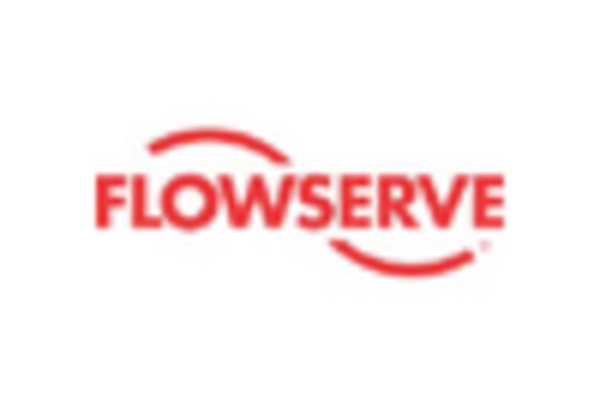Rising Focus on Energy Efficiency
The Multiple Orifice Flow Control Valve Market is increasingly shaped by a rising focus on energy efficiency and sustainability. Industries are under pressure to reduce energy consumption and minimize waste, leading to a greater emphasis on optimizing fluid flow systems. Multiple orifice flow control valves are particularly effective in achieving these goals, as they allow for precise control of flow rates, thereby reducing energy usage. Recent studies indicate that implementing these valves can lead to energy savings of up to 30% in certain applications. This potential for energy efficiency is likely to attract more industries to adopt multiple orifice flow control valves, thereby driving market growth. As sustainability becomes a core business strategy, the demand for these valves is expected to rise.
Technological Innovations in Flow Control
The Multiple Orifice Flow Control Valve Market is witnessing a wave of technological innovations that enhance the functionality and efficiency of flow control systems. Advancements in materials, design, and automation are enabling the development of more sophisticated valves that offer improved performance. For example, the integration of smart technologies allows for real-time monitoring and control, which can lead to significant operational savings. Market data indicates that the adoption of smart flow control solutions is on the rise, with a projected increase in market share over the next few years. This trend suggests that as industries seek to optimize their processes, the demand for technologically advanced multiple orifice flow control valves will likely grow, driving the overall market forward.
Regulatory Compliance and Safety Standards
The Multiple Orifice Flow Control Valve Market is significantly influenced by stringent regulatory compliance and safety standards across various sectors. Governments and regulatory bodies are increasingly mandating the use of advanced flow control technologies to ensure safety and environmental protection. For instance, industries are required to implement systems that minimize leaks and optimize resource usage. This regulatory landscape creates a favorable environment for the adoption of multiple orifice flow control valves, which are designed to meet these stringent requirements. As a result, manufacturers are likely to invest in developing innovative solutions that comply with these regulations, thereby propelling market growth. The emphasis on safety and compliance is expected to contribute to a steady increase in demand for these valves in the coming years.
Expansion of Water and Wastewater Management
The Multiple Orifice Flow Control Valve Market is benefiting from the expansion of water and wastewater management initiatives. As urbanization continues to accelerate, the need for efficient water distribution and wastewater treatment systems is becoming increasingly critical. Multiple orifice flow control valves play a vital role in these systems by ensuring optimal flow regulation and pressure management. Market analysis suggests that investments in water infrastructure are projected to increase significantly, with a focus on modernizing existing systems. This trend indicates a growing market for multiple orifice flow control valves, as municipalities and private entities seek reliable solutions to manage water resources effectively. The expansion of water management initiatives is likely to drive sustained demand for these valves in the foreseeable future.
Increasing Demand in Industrial Applications
The Multiple Orifice Flow Control Valve Market is experiencing a surge in demand due to its critical role in various industrial applications. Industries such as oil and gas, water treatment, and chemical processing are increasingly adopting these valves to enhance operational efficiency. The ability of multiple orifice valves to regulate flow rates with precision is particularly valued in sectors where fluid dynamics are complex. According to recent data, the industrial sector accounts for a substantial portion of the market, with projections indicating a growth rate of approximately 5% annually. This trend suggests that as industries continue to expand and modernize, the reliance on advanced flow control solutions will likely increase, further driving the market for multiple orifice flow control valves.


















Leave a Comment